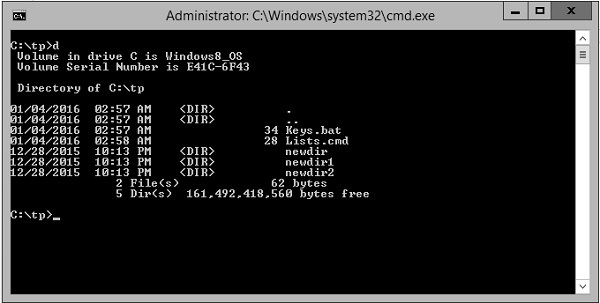- 批处理脚本 – 别名(1)
- 批处理脚本-数组
- 批处理脚本-数组(1)
- 批处理脚本 – 数组
- 批处理脚本 - 右字符串(1)
- 批处理脚本 - 空字符串(1)
- 批处理脚本-字符串(1)
- 批处理脚本 - 右字符串
- 批处理脚本 - 左字符串
- 批处理脚本 - 左字符串(1)
- 批处理脚本 - 空字符串
- 批处理脚本-字符串
- 批处理脚本-文件(1)
- 批处理脚本-文件
- 批处理脚本-命令(1)
- 批处理脚本-命令
- 批处理脚本-网络
- 批处理脚本-网络(1)
- 批处理脚本-变量
- 批处理脚本-变量(1)
- Bash 脚本 - 别名的工作(1)
- Bash 脚本 - 别名的工作
- 批处理脚本-运算符
- 批处理脚本-运算符(1)
- 批处理脚本 - 创建字符串(1)
- 批处理脚本 - 创建字符串
- 批处理脚本教程
- 批处理脚本教程(1)
- 批处理脚本-处理(1)
📅 最后修改于: 2020-11-22 17:52:22 🧑 作者: Mango
别名意味着为现有命令创建快捷方式或关键字。假设我们要执行以下命令,该命令只不过是带有/ w选项的目录列表命令,而不在目录列表中显示所有必要的详细信息。
Dir /w
假设我们要如下创建该命令的快捷方式。
dw = dir /w
当我们要执行dir / w命令时,我们只需输入dw即可。现在,单词“ dw”已成为命令Dir / w的别名。
创建别名
别名通过使用doskey命令进行管理。
句法
DOSKEY [options] [macroname=[text]]
其中
-
macroname-宏的简称。
-
文本-要撤消的命令。
以下是可以显示在DOSKEY命令中的选项的说明。
| S.No. | Options & Description |
|---|---|
| 1. |
/REINSTALL Installs a new copy of Doskey |
| 2. |
/LISTSIZE = size Sets size of command history buffer. |
| 3. |
/MACROS Displays all Doskey macros. |
| 4. |
/MACROS:ALL Displays all Doskey macros for all executables which have Doskey macros. |
| 5. |
/MACROS:exename Displays all Doskey macros for the given executable. |
| 6. |
/HISTORY Displays all commands stored in memory. |
| 7. |
/INSERT Specifies that new text you type is inserted in old text. |
| 8. |
/OVERSTRIKE Specifies that new text overwrites old text. |
| 9. |
/EXENAME = exename Specifies the executable. |
| 10. |
/MACROFILE = filename Specifies a file of macros to install. |
| 11. |
macroname Specifies a name for a macro you create. |
| 12. |
text Specifies commands you want to record. |
例
创建一个名为keys.bat的新文件,并在该文件中输入以下命令。下面的命令创建两个别名,如果是cd命令,则创建一个别名,它将自动转到名为test的目录。另一个是用于dir命令。
@echo off
doskey cd = cd/test
doskey d = dir
执行命令后,您将能够在命令提示符下运行这些别名。
输出
下面的屏幕快照显示了执行上面创建的批处理文件后,您可以自由输入’d’命令,它会为您提供目录列表,这意味着您的别名已创建。

删除别名
可以通过将宏的值设置为NULL来删除别名或宏。
例
@echo off
doskey cd = cd/test
doskey d = dir
d=
在上面的示例中,我们首先将宏d设置为d = dir。之后,我们将其设置为NULL。因为我们将d的值设置为NULL,所以宏d将被删除。
替换别名
可以通过将宏的值设置为新的所需值来替换别名或宏。
例
@echo off
doskey cd = cd/test
doskey d = dir
d = dir /w
在上面的示例中,我们首先将宏d设置为d = dir。之后,我们将其设置为dir / w。由于我们已将d的值设置为新值,因此别名“ d”现在将采用新值。